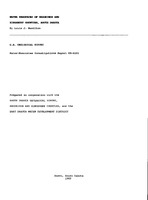Surface water and groundwater resources are widely distributed in Brookings and Kingsbury Counties, an area of nearly 1,700 sq mi of glaciated plains of the Coteau des Prairies plateau in eastern South Dakota. The resources are relatively undeveloped except for large withdrawals for irrigation from shallow glacial aquifers. Groundwater withdrawals accounted for 90% of the 16 ,000 acre-ft of water withdrawn in 1985. The Big Sioux River drains an area of about 2,400 sq mi and flows southward through Brookings County. Discharge of the Big Sioux River near Brookings has averaged 117,000 acre-ft/yr but can decrease to 17 ,600 acre-ft/yr during drought periods. West of the river are thousands of shallow ponds, marshes, and lakes. The largest, Lake Thompson in central Kingsbury County, rose nearly 20 ft during 1985-86 because of record precipitation and large overflow from upstream lakes. Six major glacial aquifers of outwash sand and gravel store 8 million acre-ft of fresh to slightly saline, very hard water beneath nearly 1,300 sq mi at depths ranging from land surface to more than 700 ft. Concentrations of dissolved solids and hardness of water from the aquifers exceed 1,000 mg/L at many places. The 600 sq mi of the surficial, freshwater Big Sioux and Vermillion East Fork aquifers contain more than 200 large-capacity wells that can be pumped from 200 to as much as 1,300 gal/min. Three extensive bedrock aquifers store 67 million acre-ft of slightly saline, soft water at depths ranging from 320 to 1,300 ft. Maximum yields for wells in the sandstone of the Codell and Dakota aquifers are estimated to be 100 gal/min. (USGS)


